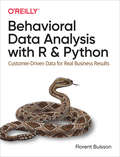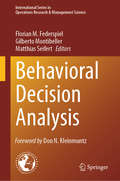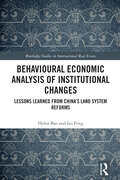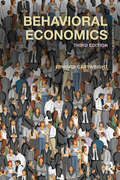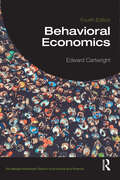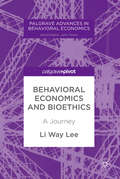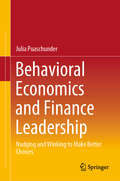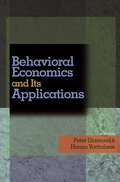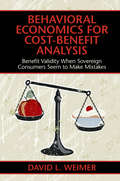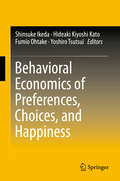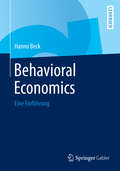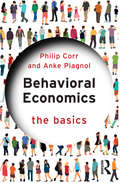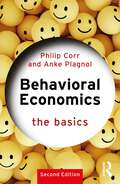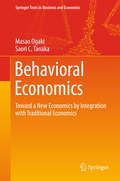- Table View
- List View
Behavior, Technology, and Organizational Development: Eric Trist and the Tavistock Institute
by Richard TrahairEric Trist was a psychologist, social scientist, and a leading figure in the field of organizational development. He was a founding member of the Tavistock Institute of Human Relations in London and spent many years in United States academia. This book delves into Trist's life to examine the evolution of his work and how he applied social science theory, knowledge, and methods to the organization of working life and its management. Richard Trahair outlines Trist's socio-technical theory of organization and how it applies to the turbulent environment that modern managers face.Trahair begins with Trist's educational career in England and his attitude toward American and English education. He also describes Trist's work to improve the United Kingdom's Army's method of selecting men for officer training in wartime, and his role in the establishment of the Civil Resettlement Units in England.In place of the traditional technology-driven bureaucracy of industry, Trist recommended that social science researchers help reorganize industries on socio-technical lines. Trist provided convincing evidence that organizations dominated by traditional attitudes were inefficient and unsatisfactory. He made it clear that seeing workers as little more than costly extensions of machines and the industrial environment as nothing but a set of competitive market forces seriously limited potential for growth.
Behavioral Business Ethics: Shaping an Emerging Field (Organization and Management Series)
by Ann E. Tenbrunsel David De CremerThis book takes a look at how and why individuals display unethical behavior. It emphasizes the actual behavior of individuals rather than the specific business practices. It draws from work on psychology which is the scientific study of human behavior and thought processes. As Max Bazerman said, "efforts to improve ethical decision making are better aimed at understanding our psychological tendencies."
Behavioral Competencies for Innovation: Using Emotional Intelligence to Foster Innovation
by Sara Bonesso Fabrizio Gerli Laura CortellazzoThis book represents the first comprehensive investigation of the role of emotional intelligence in promoting innovation in the organizational context. Offering emerging insights into the human side of innovation. This book highlights how it has become strategically important for firm innovativeness to identify and evaluate those behavioral competencies that enable entrepreneurs and professionals to generate different types of innovation (product, process, marketing, organizational and strategic innovation). It illustrates a classification of behavioral competencies for innovation and provides empirical evidence collected through the application of the competency-based methodology to a sample of entrepreneurs and new product development teams. This book provides practical policy and managerial implications on how to develop and evaluate behavioral competencies in the higher education and organizational settings in order to foster individual innovation capacity.
Behavioral Competencies of Digital Professionals: Understanding the Role of Emotional Intelligence
by Sara Bonesso Elena Bruni Fabrizio Gerli‘I encounter many data scientists and analysts whose sole focus is solving analytical problems and developing accurate models. They all need to read this excellent book and adopt its recommendations!’. — Thomas H. Davenport, Distinguished Professor, Babson College, Research Fellow, MIT Initiative on the Digital Economy ‘This book provides a compelling, credible and sound narrative to de-code complexity by developing a set of competencies (action, social, awareness, cognitive, exploration and organizational) supported by emotional intelligence. A must read for Leaders and HR practitioners, for the intellectual curious eager to understand that Human Beings will have to remain central to Human Development’. —Paolo Gallo, Former CHRO at World Economic Forum, World Bank and European BankShedding new light on the human side of big data through the lenses of emotional and social intelligence competencies, this book advances the understanding of the requirements of the different professions that deal with big data. It also illustrates the empirical evidence collected through the application of the competency-based methodology to a sample of data scientists and data analysts, the two most in-demand big data jobs in the labor market. The book provides recommendations for the higher education system to offer better designed curricula for entry-level big data professions. It also offers managerial insights in describing how organizations and specifically HR practitioners can benefit from the competency-based approach to overcome the skill shortage that characterizes the demand for big data professional roles and to increase the effectiveness of the selection and recruiting processes.
Behavioral Data Analysis with R and Python: Customer-driven Data For Real Business Results
by Florent BuissonHarness the full power of the behavioral data in your company by learning tools specifically designed for behavioral data analysis. Common data science algorithms and predictive analytics tools treat customer behavioral data, such as clicks on a website or purchases in a supermarket, the same as any other data. Instead, this practical guide introduces powerful methods specifically tailored for behavioral data analysis.Advanced experimental design helps you get the most out of your A/B tests, while causal diagrams allow you to tease out the causes of behaviors even when you can't run experiments. Written in an accessible style for data scientists, business analysts, and behavioral scientists, thispractical book provides complete examples and exercises in R and Python to help you gain more insight from your data--immediately.Understand the specifics of behavioral dataExplore the differences between measurement and predictionLearn how to clean and prepare behavioral dataDesign and analyze experiments to drive optimal business decisionsUse behavioral data to understand and measure cause and effectSegment customers in a transparent and insightful way
Behavioral Decision Analysis (International Series in Operations Research & Management Science #350)
by Matthias Seifert Gilberto Montibeller Florian M. FederspielThis book lays out a foundation and taxonomy for Behavioral Decision Analysis, featuring representative work across various domains. Traditional research in the domain of Decision Analysis has focused on the design and application of logically consistent tools to support decision makers during the process of structuring problem complexity, modeling uncertainty, generating predictions, eliciting preferences, and, ultimately, making better decisions. Two commonly held assumptions are that the decision maker’s cognitive belief system is fully accessible and that this system can be understood and formalized by trained analysts. However, in past years, an active line of research has emerged studying instances in which such assumptions may not hold. This book unites this community under the common theme of Behavioral Decision Analysis. The taxonomy used in this book categorizes research based on task focus (prediction or decision) and behavioral level (individual or group). Two theoretical lenses that lie at the interface between (1) normative and descriptive research, and (2) normative and prescriptive research are introduced. The book then proceeds to highlight representative works across the two lenses focused on individual and group-level decision making. Featuring various methodologies and applications, the book serves as a reference for researchers, students, and professionals across different disciplines with a common interest in Behavioral Decision Analysis.
Behavioral Decision Theory: Psychological and Mathematical Descriptions of Human Choice Behavior
by Kazuhisa TakemuraThis book is the second edition of Behavioral Decision Theory, published in 2014. The main approach and structure of this book have been retained in the new edition. However, this second edition provides a fresh overview of the idea of behavioral decision theory and related research findings such as theoretical and empirical discoveries of preference formation, time discounting, social interaction, and social decision making. The book covers a wide range from classical to relatively recent major studies concerning behavioral decision theory, which, in brief, is a general term for descriptive theories to explain the psychological knowledge related to people’s decision-making behavior. It is called a theory but is actually a combination of various psychological theories, for which no axiomatic systems—such as those associated with the utility theory widely used in economics—have been established.The utility theory is often limited to qualitative knowledge; however, as the studies of Nobel laureates H. A. Simon, D. Kahneman, and R. Thaler have suggested, the psychological methodology and knowledge of behavioral decision theory have been applied widely in such fields as economics, business administration, and engineering and are expected to become even more useful in the future. Research into people’s decision making represents an important part in those fields, various aspects of which overlap with the scope of behavioral decision theory. This theory is closely related to behavioral economics and behavioral finance, which have come into greater use in recent years. This book will appeal especially to graduate students, advanced undergraduate students, and researchers who are interested in decision-making phenomena.
Behavioral Economic Analysis of Institutional Changes: Lessons Learned from China's Land System Reforms (Routledge Studies in International Real Estate)
by Helen Bao Lei FengThis book examines the evolution of China’s rural land system through an integrated lens of institutional and behavioural economics. It traces seventy years of reform, from collective farming to market-oriented land transfers, to explain how central policy, local implementation and farmers’ responses interact to shape institutional change. Moving beyond standard accounts focused on property rights and transaction costs, the book introduces a dynamic framework based on Prospect Theory, incorporating cognitive biases, social norms and bounded rationality. Drawing on two large-scale rural household surveys, the book combines empirical analysis with historical case studies to explore how reforms were received, adapted and resisted.This book will benefit researchers, policymakers and graduate students interested in institutional change, land policy or Chinese rural development. It offers new tools to understand policy implementation in environments marked by uncertainty, decentralisation and informal constraints. By highlighting how behavioural factors mediate formal rules, the book provides insights that extend beyond China, informing the design of effective land and property rights reforms globally.
Behavioral Economics (Routledge Advanced Texts in Economics and Finance)
by Edward CartwrightOver the last few decades behavioral economics has revolutionized the discipline. It has done so by putting the human back into economics, by recognizing that people sometimes make mistakes, care about others and are generally not as cold and calculating as economists have traditionally assumed. The results have been exciting and fascinating, and have fundamentally changed the way we look at economic behavior. This textbook introduces all the key results and insights of behavioral economics to a student audience. Ideas such as mental accounting, prospect theory, present bias, inequality aversion and learning are explained in detail. These ideas are also applied in diverse settings such as auctions, stock market crashes, charitable donations and health care, to show why behavioral economics is crucial to understanding the world around us. Consideration is also given to what makes people happy, and how we can potentially nudge people to be happier. This new edition contains expanded and updated coverage of contract theory, bargaining in the family, time and risk, and stochastic reference points, among other topics, to ensure that readers are kept up to speed with this fast-paced field. The companion website is also updated with a range of new questions and worked examples. This book remains the ideal introduction to behavioral economics for advanced undergraduate and graduate students.
Behavioral Economics (Routledge Advanced Texts in Economics and Finance)
by Edward CartwrightOver the last few decades behavioral economics has revolutionized the discipline. It has done so by putting the human back into economics, by recognizing that people sometimes make mistakes, care about others and are generally not as cold and calculating as economists have traditionally assumed. The results have been exciting and fascinating, and have fundamentally changed the way we look at economic behavior. This textbook introduces all the key results and insights of behavioral economics to a student audience. Ideas such as mental accounting, prospect theory, present bias, inequality aversion and learning are explained in detail. These ideas are also applied in diverse settings, such as auctions, stock market crashes, charitable donations and health care, to show why behavioral economics is crucial to understanding the world around us. Consideration is also given to what makes people happy, and how we can potentially nudge people to be happier. This new edition contains expanded and updated coverage of several topics and applications, including fraud and cybercrime, cryptocurrency, public health messaging, and the COVID-19 pandemic. The companion website is also updated with a range of new questions and worked examples. This book remains the ideal introduction to behavioral economics for advanced undergraduate and graduate students.
Behavioral Economics (Routledge Advanced Texts in Economics and Finance)
by Edward CartwrightOver the last few decades behavioral economics has revolutionized the discipline. It has done so by putting the human back into economics, by recognizing that people sometimes make mistakes, care about others and are generally not as cold and calculating as economists have traditionally assumed. The results have been exciting and fascinating, and have fundamentally changed the way we look at economic behavior.This textbook introduces all the key results and insights of behavioral economics to a student audience. Ideas such as mental accounting, prospect theory, present bias, inequality aversion and learning are explained in detail. These ideas are also applied in diverse settings, such as auctions, stock market crashes, charitable donations and health care, to show why behavioral economics is crucial to understanding the world around us. Consideration is also given to what makes people happy, and how we can potentially nudge people to be happier.This new edition contains expanded and updated coverage of several topics and applications, including fraud and cybercrime, cryptocurrency, public health messaging, and the COVID-19 pandemic. The companion website is also updated with a range of new questions and worked examples. This book remains the ideal introduction to behavioral economics for advanced undergraduate and graduate students.
Behavioral Economics For Dummies
by Morris AltmanA guide to the study of how and why you really make financial decisionsWhile classical economics is based on the notion that people act with rational self-interest, many key money decisions--like splurging on an expensive watch--can seem far from rational. The field of behavioral economics sheds light on the many subtle and not-so-subtle factors that contribute to our financial and purchasing choices. And in Behavioral Economics For Dummies, readers will learn how social and psychological factors, such as instinctual behavior patterns, social pressure, and mental framing, can dramatically affect our day-to-day decision-making and financial choices.Based on psychology and rooted in real-world examples, Behavioral Economics For Dummies offers the sort of insights designed to help investors avoid impulsive mistakes, companies understand the mechanisms behind individual choices, and governments and nonprofits make public decisions.A friendly introduction to the study of how and why people really make financial decisionsThe author is a professor of behavioral and institutional economics at Victoria UniversityAn essential component to improving your financial decision-making (and even to understanding current events), Behavioral Economics For Dummies is important for just about anyone who has a bank account and is interested in why--and when--they spend money.
Behavioral Economics and Bioethics: A Journey (Palgrave Advances In Behavioral Economics Ser.)
by Li Way LeeThis book takes readers on a journey through the wide universe of bioethics, raising the following question: what is the proper attitude towards health, life, and death from the perspective of contemporary behavioral economics? Drawing on fields as diverse as economics, ethics, ecology, biology, and philosophy, this book seeks to uncover the bioethics we accomplish, not the moral principles that we advocate. This book covers life-and-death issues arranged around five themes: selves, persons, populations, species, and “Future Earth”. Ultimately, the author illustrates two kinds of justice: static and dynamic. Static justice prevails whenever parties are free to bargain with each other, while dynamic justice follows from parties' interactions over time. An examination into these types of justice reveals one particularly striking phenomenon: attempts by others to tip the balance of justice have a tendency to backfire. Of primary interest to behavioral economists, this book will also appeal to scholars studying bioethics, ecology, medicine, and philosophy, as well as all people dealing with issues of health, dying, and death.
Behavioral Economics and Finance Leadership: Nudging and Winking to Make Better Choices
by Julia PuaschunderThis book explores human decision-making heuristics and studies how nudging and winking can help citizens to make rational choices. By applying the behavioral economics approach to political outcomes, it demonstrates how economics can be employed for the greater societal good. It starts with a review of the current literature on human decision-making failures in Europe and North America, presenting the wide range of nudges and winks developed to curb the harmful consequences of human decision-making fallibility. It then discusses the use of mental heuristics, biases and nudges in the finance domain to benefit economic markets by providing clear communication strategies. Lastly, the author proposes clear leadership and followership directives on nudging in the digital age. This book appeals to scholars and policy makers interested in rational decision-making and the use of nudging and winking in the digital age.
Behavioral Economics and Its Applications
by Peter Diamond Hannu VartiainenIn the last decade, behavioral economics, borrowing from psychology and sociology to explain decisions inconsistent with traditional economics, has revolutionized the way economists view the world. But despite this general success, behavioral thinking has fundamentally transformed only one field of applied economics-finance. Peter Diamond and Hannu Vartiainen's Behavioral Economics and Its Applications argues that behavioral economics can have a similar impact in other fields of economics. In this volume, some of the world's leading thinkers in behavioral economics and general economic theory make the case for a much greater use of behavioral ideas in six fields where these ideas have already proved useful but have not yet been fully incorporated--public economics, development, law and economics, health, wage determination, and organizational economics. The result is an attempt to set the agenda of an important development in economics--an agenda that will interest policymakers, sociologists, and psychologists as well as economists. Contributors include Ian Ayres, B. Douglas Bernheim, Truman F. Bewley, Colin F. Camerer, Anne Case, Michael D. Cohen, Peter Diamond, Christoph Engel, Richard G. Frank, Jacob Glazer, Seppo Honkapohja, Christine Jolls, Botond Koszegi, Ulrike Malmendier, Sendhil Mullainathan, Antonio Rangel, Emmanuel Saez, Eldar Shafir, Sir Nicholas Stern, Jean Tirole, Hannu Vartiainen, and Timothy D. Wilson.
Behavioral Economics for Cost-Benefit Analysis Benefit Validity: Benefit Validity When Sovereign Consumers Seem to Make Mistakes
by David L. WeimerHow should policy analysts assess 'benefit validity' when behavioral anomalies appear relevant? David L. Weimer provides thoughtful answers through practical guidelines. Behavioral economists have identified a number of situations in which people appear not to behave according to the neoclassical assumptions underpinning welfare economics and its application to the assessment of the efficiency of proposed public policies through cost-benefit analysis. This book introduces the concept of benefit validity as a criterion for estimating benefits from observed or stated preference studies, and provides practical guidelines to help analysts accommodate behavioral findings. It considers benefit validity in four areas: violations of expected utility theory, unexpectedly large differences between willingness to pay and willingness to accept, non-exponential discounting, and harmful addiction. In addition to its immediate value to practicing policy analysts, it helps behavioral economists identify issues where their research programs can make practical contributions to better policy analysis. Provides an accessible overview of neoclassical welfare economics Reviews progress toward developing a behaviorally-informed welfare economics Provides practical guidelines for dealing with behavioral challenges to CBA
Behavioral Economics for Leaders: Research-Based Insights on the Weird, Irrational, and Wonderful Ways Humans Navigate the Workplace
by Matthias SutterEvery leader should know the surprising research and strange conclusions of behavioral economics--for fairness, teamwork and productivity You and your colleagues don’t always make rational decisions. Sometimes that's a problem that leaders must address, and and sometimes that can be a good thing--when employees put their colleagues interests ahead of their own. Dr. Matthias Sutter, a leading economist from Germany's world-renowned Max Planck Institute explains the latest surprising insights based on behavioral economics research. The book explains how people tick, how they react to incentives (monetary or non-monetary in nature) and what that means for working together—or against each other—at work. Dr. Sutter summarizes new and classic behavorial science research that applies the everyday business world, so leaders can improve teams and organizations, the research-based way. Find out which factors are important for professional success, from career entry to senior management. Start your career on the right footing, advance quicker, and strategize how to meet your goals Understand what’s holding your colleagues back from productivity and implement evidence-based changes Identify hidden biases in yourself and others to overcome inequalities and inefficiencies Become a better leader and decision-maker by learning to interpret people’s actions Individuals, organizations, and teams will benefit from the often-counterintuitive wisdom in this book. Based on the author’s 20 years of research—plus the findings of the world’s top behavioral economists—Behavioral Economics for Leaders can help you get your team and your organization where you want to lead it.
Behavioral Economics of Preferences, Choices, and Happiness
by Shinsuke Ikeda Hideaki Kiyoshi Kato Fumio Ohtake Yoshiro TsutsuiThis book is a collection of important contributions by Japanese researchers and their coauthors to present current advances in behavioral economics and finance, particularly in relation to decision making and human well-being. The topics covered in this volume include decision making under the conditions of inter-temporal choices, risk and social relations, happiness and the neuro-scientific/biological basis of behavior. The book includes works of research, both theoretical and empirical, on time discounting, time preferences, risk aversion, altruism, social status, happiness, addiction, limited attention and health and financial investments. The authors of the chapters add supplementary discussions to survey more recent advances on related topics or to provide detailed information that were abbreviated in the original publications. The addenda will enable readers to deepen their understanding of decision making and human well-being.
Behavioral Economics: A History
by Floris HeukelomThis book presents a history of behavioral economics. The recurring theme is that behavioral economics reflects and contributes to a fundamental reorientation of the epistemological foundations upon which economics had been based since the days of Smith, Ricardo, and Mill. With behavioral economics, the discipline has shifted from grounding its theories in generalized characterizations to building theories from behavioral assumptions directly amenable to empirical validation and refutation. The book proceeds chronologically and takes the reader from von Neumann and Morgenstern's axioms of rational behavior, through the incorporation of rational decision theory in psychology in the 1950s 1970s, and to the creation and rise of behavioral economics in the 1980s and 1990s at the Sloan and Russell Sage Foundations.
Behavioral Economics: Eine Einführung
by Hanno BeckSeit den siebziger Jahren haben die Erkenntnisse und Forschungen der Psychologie auch Einzug in die Wirtschaftswissenschaften gehalten – sie sollen das Menschenbild der Ökonomen und ihre Modelle realistischer machen. Dieses Buch beschreibt die wichtigsten Methoden, Konzepte und Erkenntnisse der verhaltenswissenschaftlichen Ökonomik (Behavioral Economics) und weitere dazugehörige Forschungsgebiete wie Glücksforschung, Fairness und Neuroökonomie. Das Lehrbuch stellt die wichtigsten theoretischen und empirischen Befunde und Ideen vor, um sie anschließend einer kritischen Würdigung zu unterziehen. Es ist sowohl für Studierende geeignet als auch für Dozenten und Wissenschaftler, die sich über den aktuellen Forschungsstand der Disziplin informieren wollen.
Behavioral Economics: Evidence, Theory, and Welfare
by Brandon LehrBehavioral Economics: Evidence, Theory, and Welfare provides an engaging and accessible introduction to the motivating questions, real-world evidence, theoretical models, and welfare implications of behavioral economics concepts. Applications and examples — from household decisions, finance, public finance, labor, business, health, development, politics, education, energy, and sports — illustrate the broad relevance of behavioral economics for consumers, firms, markets, and policy makers alike. This textbook provides readers with both the intuition and analytical tools to apply behavioral economics concepts in understanding the complex social world. Each part of the book covers a key concept, beginning with a range of empirical evidence that is anomalous within the standard economics framework. In light of this evidence, a second chapter introduces and applies a nonstandard behavioral modeling approach. The last chapter of each part explores market reactions and policy responses to individuals behaving in nonstandard ways. Numerous exercises of varying types and levels provide readers the opportunity to check and enrich their understanding. The book’s clear structure orients readers to the many concepts of behavioral economics. It also highlights the process by which economists evaluate evidence and disentangle theories with different social welfare implications. Accessible to students from diverse economic backgrounds, this textbook is an ideal resource for courses on behavioural economics, experimental economics and related areas. The accompanying Solutions Manual further extends learning and engagement.
Behavioral Economics: Moving Forward
by Fabrizio Ghisellini Beryl Y. ChangThis book sets the agenda to turn behavioral economics, which has long been considered a subordinate discipline, into mainstream economics. Ghisellini and Chang expose the conceptual and empirical inadequacy of conventional economics using illustrations of real world decision-making in a dynamic environment, including evidence from the global financial crisis. With a rigorous yet accessible style, they give a comprehensive overview of behavioral economics and of the current state of play in the field across different schools of thought. Seven major conceptual problems still affecting the development of behavioral economics are identified and the authors propose research avenues to address these issues and allow the discipline to receive its long-awaited recognition.Crucial reading for researchers and students looking for insights into the many unsolved problems of economics.
Behavioral Economics: The Basics (The Basics)
by Philip Corr Anke PlagnolBehavioral economics is everywhere – whether used by governments to shape our judgement and decision making, advertisers and marketers to sell products, or even politicians to sell policies, its insights are important and far-reaching. Behavioral Economics: The Basics is the first book to provide a rigorous yet accessible overview of the growing field that attempts to uncover the psychological processes which mediate all the economic judgements and decisions we make. In seven accessible chapters, the book answers questions like: What is behavioral economics? How does it help us to understand economic behavior? What does it tell us about how people form judgements and make decisions in their private and public lives? What does it tell us about the psychological nature of financial catastrophes that afflict our economic system? With recommended further readings throughout, Behavioral Economics: The Basics is essential for all students taking courses in behavioral economics, economic psychology, consumer psychology, microeconomics and game theory, and also for professionals looking for an accessible introduction to the topic. Further online resources may be found at www.behaviouraleconomicsbasics.net
Behavioral Economics: The Basics (The Basics)
by Philip Corr Anke PlagnolThe second edition of Behavioral Economics: The Basics summarizes behavioral economics, which uses insights from the social sciences, especially psychology, to explain real-world economic behavior. Behavioral economic insights are routinely used not only to understand the choices people make but also to influence them, whether the aim is to enable citizens to lead healthier and wealthier lives, or to turn browsers into buyers. Revised and updated throughout with fresh current-event examples, Behavioral Economics: The Basics provides a rigorous yet accessible overview of the field that attempts to uncover the psychological processes which mediate all the economic judgements and decisions we make. The book showcases how behavioral economics is rooted in some now-old (philosophical, political, and moral) ideas surrounding economics, and in an important sense is a modern expression of some long-standing criticisms of mainstream economics. It contrasts the neoclassical economic perspective (ECON) with a more realistic perspective (HUMAN – the flesh-and-blood economic agent who is not perfect in all respects but who manages to do the best under limitations and constraints). This is a comprehensive overview of the whole field, covering all the main areas, presented in a rigorous yet accessible form. It should especially appeal to students, those with an interest in applying behavioral economic knowledge in their professional life, and anyone who wants to know how they are being influenced every day of their lives by (usually unseen) behavioral insights.
Behavioral Economics: Toward a New Economics by Integration with Traditional Economics (Springer Texts in Business and Economics)
by Masao Ogaki Saori C. TanakaThis book is intended as a textbook for a course in behavioral economics for advanced undergraduate and graduate students who have already learned basic economics. The book will also be useful for introducing behavioral economics to researchers. Unlike some general audience books that discuss behavioral economics, this book does not take a position of completely negating traditional economics. Its position is that both behavioral and traditional economics are tools that have their own uses and limitations. Moreover, this work makes clear that knowledge of traditional economics is a necessary basis to fully understand behavioral economics. Some of the special features compared with other textbooks on behavioral economics are that this volume has full chapters on neuroeconomics, cultural and identity economics, and economics of happiness. These are distinctive subfields of economics that are different from, but closely related to, behavioral economics with many important overlaps with behavioral economics. Neuroeconomics, which is developing fast partly because of technological progress, seeks to understand how the workings of our minds affect our economic decision making. In addition to a full chapter on neuroeconomics, the book provides explanations of findings in neuroeconomics in chapters on prospect theory (a major decision theory of behavioral economics under uncertainty), intertemporal economic behavior, and social preferences (preferences that exhibit concerns for others). Cultural and identity economics seek to explain how cultures and people's identities affect economic behaviors, and economics of happiness utilizes measures of subjective well-being. There is also a full chapter on behavioral normative economics, which evaluates economic policies based on findings and theories of behavioral economics.




